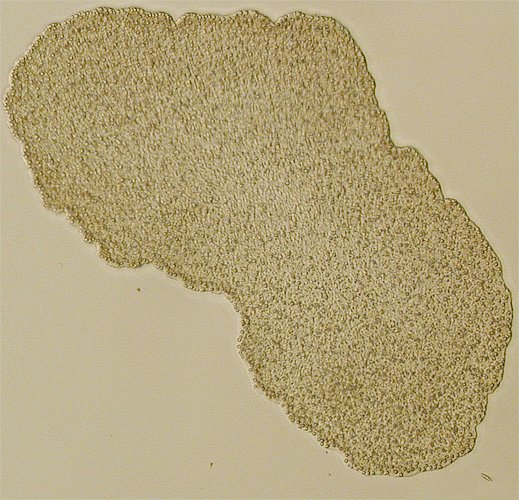- Trichoplax
Taxobox
name = "Trichoplax adhaerens"

image_width = 250px
regnum =Animalia
phylum = Placozoa
phylum_authority = Grell, 1971
classis = Trichoplacoidea
ordo = Trichoplacida
familia = Trichoplacidae
genus = "Trichoplax"
species = "T. adhaerens"
binomial = "Trichoplax adhaerens"
binomial_authority = F.E. von Schultze, 1883"Trichoplax adhaerens" is a simple balloon-like marine
animal with a body cavity filled with pressurized fluid. It is given its own phylum, called Placozoa, sometimes referred to commonly as the tablet animals, which is a direct translation from the Greek scientific name; the only other species assigned to this taxon, "Treptoplax reptans", was described in 1896 and has not been seen since, leading to doubts about its existence.Individual "Trichoplax" are soft-bodied, about 0.5 mm across, and somewhat resemble a large
amoeba . The name "T. adhaerens" was given because it tends to stick to its substrate, including glass pipettes and microscope slides. Its evolutionary relationships are still being investigated, but it may be allied with thecnidaria ns andctenophore s. Dellaporta "et al" have reported the complete mitochondrial genome sequence of "Trichoplax adhaerens" and showed that Placozoa are the most basal (that is, they branched off earliest) livingeumetazoa n phylum. [cite journal | quotes=no | author=Dellaporta "et al" | title='Mitochondrial genome of "Trichoplax adhaerens" supports Placozoa as the basal lower metazoan phylum' | journal=Proceedings of the National Academy of Sciences | year=2006 | pages=8751–6 | volume=103 | issue=23 | pmid=16731622 | doi=10.1073/pnas.0602076103]"Trichoplax" lacks organs and most tissues, including nerve cells and a
nervous system , although evidence suggests that they evolved from species with nerve cells.Fact|date=April 2007 It is made up of a few thousand cells of four types in three distinct layers: monociliated dorsal and ventral epithelia cells, ventral gland cells and the syncytial fiber cells. But sensory cells and muscle cells are apparently absent. The outermost layer (the monociliated cells) have a singlecilium , which allow the adult to move. The epithelia of "Trichoplax" lack a basal membrane and the cells are connected by beltdesmosome s. Lipid inclusions, called 'shiny spheres', are regularly distributed over the dorsal epithelia.It feeds by absorption and has been observed to form temporary bulges to trap food. It climbs atop its food and uses the ventral surface as a temporary extraorganismal gastric cavity. Digestion is both extracellular and by
phagocytosis .When not feeding "Trichoplax" is actively motile with movement effected by ventral ciliation and by the fiber cell layer and lacks any polarity in its movement.
Mansi Srivastava and her colleagues drew the first genome draft for "Trichoplax" in 2008 [cite journal | author = Mansi Srivastava, Emina Begovic, Jarrod Chapman, Nicholas H. Putnam, Uffe Hellsten, Takeshi Kawashima, Alan Kuo, Therese Mitros, Asaf Salamov, Meredith L. Carpenter, Ana Y. Signorovitch, Maria A. Moreno, Kai Kamm, Jane Grimwood, Jeremy Schmutz, Harris Shapiro, Igor V. Grigoriev, Leo W. Buss, Bernd Schierwater, Stephen L. Dellaporta & Daniel S. Rokhsar | title = The "Trichoplax" genome and the nature of placozoans | journal = Nature | volume = 454 | issue = 7207 | pages = 955-960 | date = 21 August 2008 | doi = 10.1038/nature07191 | pmid = 18719581 ] . They estimated that there are about 11,514 protein coding genes in "Trichoplax" genome. The genome size for "Trichoplax" is about 98 million base pair.
The
haploid number of chromosomes is six. It has the smallest amount ofDNA yet measured for any animal with only 50 megabases (80 femtograms per cell). A "Trichoplax" genome sequencing project has recently been completed. [cite web|url=http://opa.yale.edu/news/article.aspx?id=5979 |title=Trichoplax Genome Sequenced - "Rosetta Stone" for Understanding Evolution]Putative eggs have been observed, but they degrade at the 32-64 cell stage. Neither embryonic development nor sperm have been observed, however "Trichoplax" genomes show evidence of sexual reproduction. [cite journal | quotes=no | author=Signorovitch AY, Dellaporta SL, Buss LW | title=Molecular signatures for sex in the Placozoa | journal=
Proceedings of the National Academy of Sciences | year=2005 | pages=15518–22 | volume=102 | issue=43 | pmid=16230622 | doi=10.1073/pnas.0504031102] Asexual reproduction by binary fission is the primary mode of reproduction observed in the lab."Trichoplax" were discovered on the walls of a marine aquarium in the 1880s, and have rarely been observed in their natural habitat. [cite journal | quotes=no | author=Maruyama YK | title=Occurrence in the field of a long-term, year-round, stable population of placozoans | journal=Biol Bull | year=2004 | pages=55–60 | volume=206 | issue=1 | pmid=14977730 | doi = 10.2307/1543198 ] The full extent of their natural range is unknown, but they are easily collected in tropical and subtropical latitudes around the world.
Of the 11,514 genes identified in the six chromosomes of "Trichoplax", 80% are shared with cnidarians and bilaterians. "Trichoplax" also shares over 80% of its
introns —the regions within genes that are not translated into proteins—with humans. Thisjunk DNA forms the basis ofregulatory gene networks. The arrangement of genes is conserved between the "Trichoplax" and human genomes. This contrasts to other model systems such as fruit flies and soil nematodes that have experienced a paring down of non-coding regions and a loss of the ancestral genome organizations. [ [http://www.astrobio.net/news/modules.php?op=modload&name=News&file=article&sid=2857&mode=thread&order=0&thold=0 Primitive Pancake] at Phyorg.com, Based on a DOE/Joint Genome Institute news release. Aug 30, 2008]References
External links
* [http://metamorphnet.org/pb/wp_1c29c969.html?0.8643881388989471 Movies of Trichoplax]
* [http://www.peabody.yale.edu/collections/iz/iz_genome.html The "Trichoplax" Genome Project at the Yale Peabody Museum]
* [http://www.microscopy-uk.org.uk/mag/artoct98/tricho.html A Weird Wee Beastie: Trichoplax adhaerens]
* [http://www.ecolevol.de/index.php?option=com_content&task=category§ionid=5&id=57&Itemid=93 Research articles from the ITZ, TiHo Hannover]
* [http://www.ucmp.berkeley.edu/phyla/placozoa/placozoa.html Information page from the University of California at Berkeley]
* -Mitochondrial DNA and16S rRNA analysis and phylogeny of "Trichoplax adhaerens"
* [http://ecolevol.de/pubs/2005/syed_schie_vie_milieu.pdf Historical overview of "Trichoplax" research]
* [http://www.sciencedaily.com/releases/2008/08/080820163002.htm Science Daily:Genome Of Simplest Animal Reveals Ancient Lineage, Confounding Array Of Complex Capabilities]
Wikimedia Foundation. 2010.
